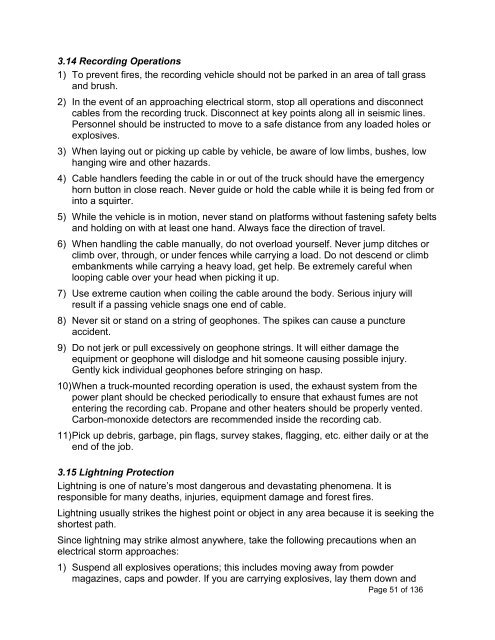IAGC LAND GEOPHYSICAL SAFETY MANUAL Edition 9 ... - CGISS
IAGC LAND GEOPHYSICAL SAFETY MANUAL Edition 9 ... - CGISS
IAGC LAND GEOPHYSICAL SAFETY MANUAL Edition 9 ... - CGISS
- No tags were found...
Create successful ePaper yourself
Turn your PDF publications into a flip-book with our unique Google optimized e-Paper software.
3.14 Recording Operations1) To prevent fires, the recording vehicle should not be parked in an area of tall grassand brush.2) In the event of an approaching electrical storm, stop all operations and disconnectcables from the recording truck. Disconnect at key points along all in seismic lines.Personnel should be instructed to move to a safe distance from any loaded holes orexplosives.3) When laying out or picking up cable by vehicle, be aware of low limbs, bushes, lowhanging wire and other hazards.4) Cable handlers feeding the cable in or out of the truck should have the emergencyhorn button in close reach. Never guide or hold the cable while it is being fed from orinto a squirter.5) While the vehicle is in motion, never stand on platforms without fastening safety beltsand holding on with at least one hand. Always face the direction of travel.6) When handling the cable manually, do not overload yourself. Never jump ditches orclimb over, through, or under fences while carrying a load. Do not descend or climbembankments while carrying a heavy load, get help. Be extremely careful whenlooping cable over your head when picking it up.7) Use extreme caution when coiling the cable around the body. Serious injury willresult if a passing vehicle snags one end of cable.8) Never sit or stand on a string of geophones. The spikes can cause a punctureaccident.9) Do not jerk or pull excessively on geophone strings. It will either damage theequipment or geophone will dislodge and hit someone causing possible injury.Gently kick individual geophones before stringing on hasp.10) When a truck-mounted recording operation is used, the exhaust system from thepower plant should be checked periodically to ensure that exhaust fumes are notentering the recording cab. Propane and other heaters should be properly vented.Carbon-monoxide detectors are recommended inside the recording cab.11) Pick up debris, garbage, pin flags, survey stakes, flagging, etc. either daily or at theend of the job.3.15 Lightning ProtectionLightning is one of nature’s most dangerous and devastating phenomena. It isresponsible for many deaths, injuries, equipment damage and forest fires.Lightning usually strikes the highest point or object in any area because it is seeking theshortest path.Since lightning may strike almost anywhere, take the following precautions when anelectrical storm approaches:1) Suspend all explosives operations; this includes moving away from powdermagazines, caps and powder. If you are carrying explosives, lay them down andPage 51 of 136
















